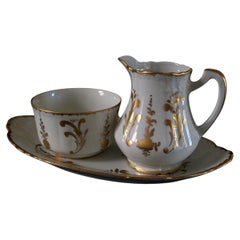Limoges Birks
Mid-20th Century French French Provincial Tea Sets
Porcelain
People Also Browsed
Late 20th Century Contemporary Figurative Drawings and Watercolors
Paper, Watercolor
Vintage 1910s American Arts and Crafts Vases
Porcelain
2010s Italian Mid-Century Modern Table Lamps
Murano Glass
Antique 1860s French Louis XVI Decorative Boxes
Bronze
20th Century American Mid-Century Modern Glass
Glass
20th Century American Modern Figurative Paintings
Oil
Early 20th Century French Napoleon III Porcelain
Porcelain
Late 20th Century English Victorian Tea Sets
Majolica
Mid-20th Century American Mid-Century Modern Windsor Chairs
Cane, Walnut
Antique Late 19th Century European Rococo Centerpieces
Porcelain
Early 2000s Art Deco Figurative Drawings and Watercolors
Watercolor
Early 2000s Art Deco Figurative Drawings and Watercolors
Watercolor
Early 2000s Art Deco Figurative Drawings and Watercolors
Watercolor
20th Century French Neoclassical Tableware
Ceramic, Porcelain, Paint
Early 20th Century American Folk Art Sculptures and Carvings
Pine
Late 20th Century French Decorative Boxes
Porcelain
A Close Look at French-provincial Furniture
Removed from the fashions of the court, French Provincial style developed in the provinces of the country, such as Provence, Normandy, the Loire Valley and Bordeaux. Dating to the 17th and 18th centuries, French Provincial furniture was not as ostentatious as the designs being produced for the royal palaces, but elegant S-shape cabriole legs and ornate carvings elevated the sturdy chairs, sofas, tables and bedroom furniture intended for everyday use.
Although it varies by region, antique French Provincial furniture is unified by solid construction and an artisanal attention to design. While this furniture often followed the metropolitan trends — including the Rococo or neoclassical aesthetics of Louis XIV, Louis XV and Louis XVI — since it was produced in the French countryside it was more subdued with nods to its rustic settings.
Local materials like fruitwoods, oak, beech and walnut were used to construct large French Provincial armoires for storage and comfortable armchairs with rush-woven seats. Wrought-iron elements and carvings like floral details and scallop patterns were common as ornamentation. Furniture was frequently painted white or other muted colors that coordinated with gilt and would acquire a patina of age over time. Other wood was just stained with vibrant fabric such as toile de Jouy, which sometimes depicted pastoral scenes, adding color as upholstery.
The style arrived in the United States after World War I, with soldiers returning home wanting furniture like what they had seen in the rural homes and castles of France. In Grand Rapids, Michigan, designer John Widdicomb split from his family business, the Widdicomb Furniture Company, and had been focusing on Louis XV– and French Provincial–style furnishings since the early 1900s. Other American manufacturers such as Baker, Drexel, Henredon and Thomasville also responded to demand. Today antique French Provincial pieces and reproductions continue to be popular.
Find a collection of antique French Provincial dining tables, seating, decorative objects and other furniture on 1stDibs.
Finding the Right Tea-sets for You
Ready to serve high tea and brunch for your family and friends? Start with the right antique, new or vintage tea set.
Tea is a multicultural, multinational beverage and isn’t confined to any particular lifestyle or age group. It has humble beginnings, and one of its best-known origin stories places the first cups of tea in 2700 B.C. in China, where it was recognized for its medicinal properties. Jump ahead to 17th-century England, when Chinese tea began to arrive at ports in London. During the early 1800s, tea became widely affordable, and the concept of teatime took shape all over England. Today, more than 150 million people reportedly drink tea daily in the United States.
Early tea drinkers enjoyed their beverage in a bowl, and English potters eventually added a handle to the porcelain bowls so that burning your fingers became less of a teatime hazard. With the rise in the popularity of teatime, tea sets, also referred to as tea service, became a hot commodity.
During Queen Victoria’s reign, teakettles and coffeepots were added to tea services that were quite large — indeed, small baked goods were served with your drink back then, and a tea set could include many teacups and saucers, a milk pot and other accessories.
During the early 1920s, a sterling-silver full tea service and tray designed by Tiffany & Co. might include a hot-water kettle on a stand, a coffeepot, teapot, a creamer with a small lip spout, a waste bowl and a bowl for sugar, which the British were stirring into tea as early as the 18th century.
But you don’t have to limit your tea set to Victorian or Art Deco styles — shake up teatime with an artful contemporary service. If the bold porcelain cups and saucers by Italian brand Seletti are too unconventional for your otherwise subdued tea circle, find antique services on 1stDibs from Japan, France and other locales as well as vintage mid-century modern tea sets and neoclassical designs.
